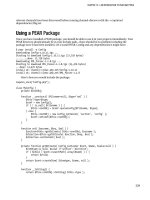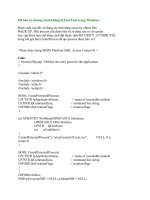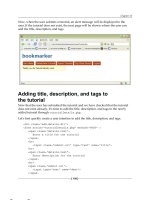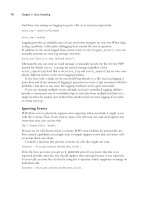PHP 5/MySQL Programming- P8 ppt
Bạn đang xem bản rút gọn của tài liệu. Xem và tải ngay bản đầy đủ của tài liệu tại đây (122.2 KB, 5 trang )
A PHP program looks a lot like a typical HTML page. The difference is the special
<? ?> tag, which specifies the existence of PHP code. Any code inside the tag is
read by the PHP interpreter and then converted into HTML code. The code written
between the
<? and ?> symbols is PHP code. I added two commands to the page.
Look at the output of the program shown in Figure 1.4. You might be surprised.
Examining the Results
This page has three distinct types of text.
•
Hello in PHP is ordinary HTML. I wrote it just like a regular HTML page,
and it was displayed just like regular HTML.
•
Hello, world! was written by the PHP program embedded in the page.
• The rest of the page is a bit mysterious. It contains a lot of information
about the particular PHP engine being used. It actually stretches on for
several pages. The
phpInfo() command generated all that code. This
command displays information about the PHP installation.
It isn’t that important to understand all the information displayed by the
phpInfo() command. It’s much more critical to appreciate that when the user
requests the
hello.html Web page, the text is first run through the PHP inter-
preter. This program scans for any PHP commands, executes them, and prints
HTML code in place of the original commands. All the PHP code is gone by the
time a page gets to the user.
13
C
h
a
p
t
e
r
1
E
x
p
l
o
r
i
n
g
t
h
e
P
H
P
E
n
v
i
r
o
n
m
e
n
t
FIGURE 1.4
The page mixes
HTML with some
other things.
For proof of this, point your browser at hello.php and view the source code. It
looks something like this:
<html>
<head>
<title>Hello in PHP</title>
</head>
<body>
<h1>Hello in PHP</h1>
Hello, world!<!DOCTYPE HTML PUBLIC “-//W3C//DTD HTML 4.01 Transitional//EN”>
<html>
<head><style type=”text/css”><!—
a { text-decoration: none; }
a:hover { text-decoration: underline; }
h1 { font-family: arial, helvetica, sans-serif; font-size: 18pt; font-
weight: bold;}
h2 { font-family: arial, helvetica, sans-serif; font-size: 14pt; font-
weight: bold;}
body, td { font-family: arial, helvetica, sans-serif; font-size: 10pt; }
th { font-family: arial, helvetica, sans-serif; font-size: 11pt; font-weight:
bold; }
//—></style>
<title>phpinfo()</title></head><body><table border=”0” cellpadding=”3”
cellspacing=”1” width=”600” bgcolor=”#000000” align=”center”>
<tr valign=”middle” bgcolor=”#9999cc”><td align=”left”>
<a href=” src=”/phab/ph01/hello.php?=PHPE9568F34-
D428-11d2-A769-00AA001ACF42” border=0 align=”right” alt=”PHP Logo”></a>
<h1>PHP Version 4.2.1</h1>
Note that I showed only a small part of the code generated by the phpInfo() com-
mand. Also, note that the code details might be different when you run the pro-
gram on your own machine. The key point is that the PHP code that writes
Hello,
World!
(print “Hello, World!”) is replaced with the actual text Hello, World!
More significantly, a huge amount of HTML code replaces the very simple
phpInfo() command.
A small amount of PHP code can very efficiently generate large and complex
HTML documents. This is one significant advantage of PHP. Also, by the time the
document gets to the Web browser, it’s plain-vanilla HTML code, which can be
14
P
H
P
5
/M
y
S
Q
L
P
r
o
g
r
a
m
m
i
n
g
f
o
r
t
h
e
A
b
s
o
l
u
t
e
B
e
g
i
n
n
e
r
read easily by any browser. These two features are important benefits of server-
side programming in general, and of PHP programming in particular.
As you progress through this book, you learn about many more commands for
producing interesting HTML, but the basic concept is always the same. Your PHP
program is simply an HTML page that contains special PHP markup. The PHP
code is examined by a special program on the server. The results are embedded
into the Web page before it is sent to the user.
Configuring Your Version of PHP
If you’re running your own server, you probably want to tweak your version of
PHP so it works cleanly. I have a number of suggestions for configuration that
provide a relatively friendly environment for beginning programs. In particular,
think about the following elements.
Safe Mode
This mode is a master setting that allows you to choose between ease of program-
ming and server safety. For beginners, I recommend setting safe-mode to OFF
while working on your own Web server. As you move to a production server, you
will usually have safe mode set to ON, which requires you to be a little more care-
ful about some elements. (However, most of these are advanced settings you won’t
need to worry about yet. The most important reason to have safe mode off right
now is to allow access to the
register_globals directive that is described next.)
Register Globals
The register_globals parameter determines whether PHP automatically trans-
fers information from web forms to your program. (It’s okay if that doesn’t mean
much to you yet.) This feature is useful for beginning programmers, but can be
a security risk.
As you get more comfortable (after chapter 5, when I show you some alternatives
to
register_globals) you can turn off this variable to protect your code from
some potential problems. To change this variable’s value, simply type
on or off as
the value for
register globals. As with any change to php.ini, restart your Web
server to ensure the changes have taken hold.
Search in
php.ini for a line that looks like this:
register_globals = On
15
C
h
a
p
t
e
r
1
E
x
p
l
o
r
i
n
g
t
h
e
P
H
P
E
n
v
i
r
o
n
m
e
n
t
Windows Extensions
PHP comes with a number of extensions that allow you to modify its behavior.
You can add functionality to your copy of PHP by adding new modules. To find
the part of
php.ini that describes these extensions, look for windows extensions
in the php.ini file.
You’ll see some code that looks like this:
;Windows Extensions
;extension=php_bz2.dll
;extension=php_ctype.dll
;extension=php_cpdf.dll
;extension=php_curl.dll
;extension=php_cybercash.dll
;extension=php_db.dll
;extension=php_dba.dll
;extension=php_dbase.dll
;extension=php_dbx.dll
;extension=php_domxml.dll
;extension=php_dotnet.dll
;extension=php_exif.dll
;extension=php_fbsql.dll
;extension=php_fdf.dll
;extension=php_filepro.dll
;extension=php_gd.dll
;extension=php_gettext.dll
;extension=php_hyperwave.dll
;extension=php_iconv.dll
;extension=php_ifx.dll
;extension=php_iisfunc.dll
;extension=php_imap.dll
;extension=php_ingres.dll
;extension=php_interbase.dll
;extension=php_java.dll
;extension=php_ldap.dll
;extension=php_mbstring.dll
;extension=php_mcrypt.dll
;extension=php_mhash.dll
;extension=php_mssql.dll
16
P
H
P
5
/M
y
S
Q
L
P
r
o
g
r
a
m
m
i
n
g
f
o
r
t
h
e
A
b
s
o
l
u
t
e
B
e
g
i
n
n
e
r
;extension=php_oci8.dll
;extension=php_openssl.dll
;extension=php_oracle.dll
;extension=php_pdf.dll
;extension=php_pgsql.dll
;extension=php_printer.dll
;extension=php_sablot.dll
;extension=php_shmop.dll
;extension=php_snmp.dll
;extension=php_sockets.dll
;extension=php_sybase_ct.dll
;extension=php_xslt.dll
;extension=php_yaz.dll
;extension=php_zlib.dll
;;;;; I added gd2 extension
extension=php_gd2.dll
;;; I added ming support
extension=php_ming.dll
;;;;;I added mysql extension
extension=php_mysql.dll
The php.ini file that comes with PHP 5.0 has a note that says mySQL support
is built in. I found this was
not
the case in my installation. Run the phpInfo()
command (in the Hello.php program described earlier, for example) to see
exactly which extensions are active in your installation. If you don’t see an exten-
sion that you need, you can add it yourself.
Most of the extensions begin with a semicolon. This character acts like a com-
ment character and causes the line to be ignored. To add a particular extension,
simply eliminate the semicolon at the beginning of the line. I usually put a com-
ment in the code to remind myself that I added this extension.
I added the
php_mysql.dll extension. This allows support for the MySQL database
language used in the second half of this book. Add support for that library by
removing the semicolon characters from the beginning of the
mysql line.
TRAP
17
C
h
a
p
t
e
r
1
E
x
p
l
o
r
i
n
g
t
h
e
P
H
P
E
n
v
i
r
o
n
m
e
n
t









